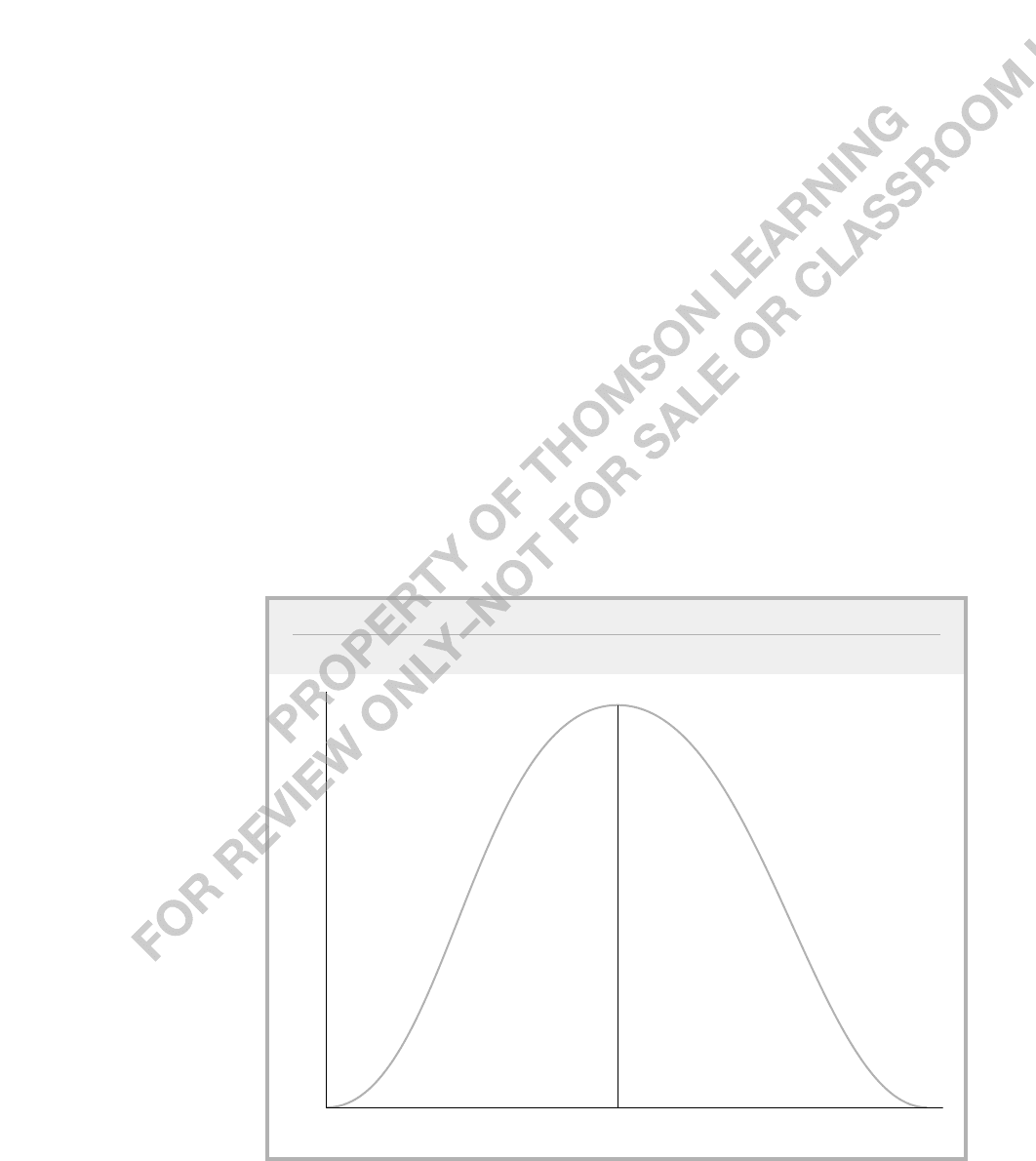Wooldridge J. Introductory Econometrics: A Modern Approach (Basic Text - 3d ed.)
Подождите немного. Документ загружается.


each person shows up is u .85. Then, P(X 100) P(X 101) P(X 102) …
P(X 120), and each of the probabilities in the sum can be found from equation (B.14)
with n 120, u .85, and the appropriate value of x (101 to 120). This is a difficult hand
calculation, but many statistical packages have commands for computing this kind of prob-
ability. In this case, the probability that more than 100 people will show up is about .659,
which is probably more risk of overbooking than the airline wants to tolerate. If, instead,
the number of reservations is 110, the probability of more than 100 passengers showing
up is only about .024.
Conditional Distributions
In econometrics, we are usually interested in how one random variable, call it Y, is related
to one or more other variables. For now, suppose that there is only one variable whose
effects we are interested in, call it X. The most we can know about how X affects Y is
contained in the conditional distribution of Y given X. This information is summarized
by the conditional probability density function, defined by
f
YX
(yx) f
X,Y
(x,y)/f
X
(x)
(B.15)
for all values of x such that f
X
(x) 0. The interpretation of (B.15) is most easily seen
when X and Y are discrete. Then,
f
YX
(yx) P(Y yX x),
(B.16)
where the right-hand side is read as “the probability that Y y given that X x.” When
Y is continuous, f
YX
(yx) is not interpretable directly as a probability, for the reasons dis-
cussed earlier, but conditional probabilities are found by computing areas under the con-
ditional pdf.
An important feature of conditional distributions is that, if X and Y are independent
random variables, knowledge of the value taken on by X tells us nothing about the prob-
ability that Y takes on various values (and vice versa). That is, f
YX
(yx) f
Y
(y), and
f
X Y
(xy) f
X
(x).
EXAMPLE B.2
(Free Throw Shooting)
Consider again the basketball-shooting example, where two free throws are to be attempted.
Assume that the conditional density is
f
YX
(11) .85, f
YX
(01) .15
f
YX
(10) .70, f
YX
(00) .30.
This means that the probability of the player making the second free throw depends on
whether the first free throw was made: if the first free throw is made, the chance of making
the second is .85; if the first free throw is missed, the chance of making the second is .70.
736 Appendix B Fundamentals of Probability

This implies that X and Y are not independent; they are dependent.
We can still compute P(X 1,Y 1) provided we know P(X 1). Assume that the prob-
ability of making the first free throw is .8, that is, P(X 1) .8. Then, from (B.15), we have
P(X 1,Y 1) P(Y 1X 1)P(X 1) (.85)(.8) .68.
B.3 Features of Probability Distributions
For many purposes, we will be interested in only a few aspects of the distributions of
random variables. The features of interest can be put into three categories: measures of
central tendency, measures of variability or spread, and measures of association between
two random variables. We cover the last of these in Section B.4.
A Measure of Central Tendency: The Expected Value
The expected value is one of the most important probabilistic concepts that we will
encounter in our study of econometrics. If X is a random variable, the expected value (or
expectation) of X, denoted E(X) and sometimes mX or simply m, is a weighted average of
all possible values of X. The weights are determined by the probability density function.
Sometimes, the expected value is called the population mean,especially when we want to
emphasize that X represents some variable in a population.
The precise definition of expected value is simplest in the case that X is a discrete ran-
dom variable taking on a finite number of values, say, {x
1
,…,x
k
}. Let f(x) denote the prob-
ability density function of X. The expected value of X is the weighted average
E(X) x
1
f(x
1
) x
2
f(x
2
) … x
k
f(x
k
)
k
j1
x
j
f(x
j
).
(B.17)
This is easily computed given the values of the pdf at each possible outcome of X.
EXAMPLE B.3
(Computing an Expected Value)
Suppose that X takes on the values 1, 0, and 2 with probabilities 1/8, 1/2, and 3/8, respec-
tively. Then,
E(X) (1)(1/8) 0(1/2) 2(3/8) 5/8.
This example illustrates something curious about expected values: the expected value of
X can be a number that is not even a possible outcome of X. We know that X takes on the
values 1, 0, or 2, yet its expected value is 5/8. This makes the expected value deficient
Appendix B Fundamentals of Probability 737

for summarizing the central tendency of certain discrete random variables, but calcula-
tions such as those just mentioned can be useful, as we will see later.
If X is a continuous random variable, then E(X) is defined as an integral:
E(X)
xf(x)dx, (B.18)
which we assume is well defined. This can still be interpreted as a weighted average. For
the most common continuous distributions, E(X) is a number that is a possible outcome
of X. In this text, we will not need to compute expected values using integration, although
we will draw on some well-known results from probability for expected values of special
random variables.
Given a random variable X and a function g(), we can create a new random variable
g(X). For example, if X is a random variable, then so is X
2
and log(X) (if X 0). The
expected value of g(X) is, again, simply a weighted average:
E[g(X)]
k
j1
g(x
j
)f
X
(x
j
) (B.19)
or, for a continuous random variable,
E[g(X)]
g(x)f
X
(x)dx. (B.20)
EXAMPLE B.4
(Expected Value of X
2
)
For the random variable in Example B.3, let g(X) X
2
. Then,
E(X
2
) (1)
2
(1/8) (0)
2
(1/2) (2)
2
(3/8) 13/8.
In Example B.3, we computed E(X) 5/8, so that [E(X)]
2
25/64. This shows that E(X
2
)
is not the same as [E(X)]
2
. In fact, for a nonlinear function g(X), E[g(X)] g[E(X)] (except
in very special cases).
If X and Y are random variables, then g(X,Y) is a random variable for any function g,
and so we can define its expectation. When X and Y are both discrete, taking on values
{x
1
,x
2
,…,x
k
} and {y
1
,y
2
,…,y
m
}, respectively, the expected value is
E[g(X,Y)]
k
h1
m
j1
g(x
h
,y
j
)f
X,Y
(x
h
,y
j
),
where f
X,Y
is the joint pdf of (X,Y). The definition is more complicated for continuous ran-
dom variables since it involves integration; we do not need it here. The extension to more
than two random variables is straightforward.
738 Appendix B Fundamentals of Probability

Properties of Expected Values
In econometrics, we are not so concerned with computing expected values from various
distributions; the major calculations have been done many times, and we will largely take
these on faith. We will need to manipulate some expected values using a few simple rules.
These are so important that we give them labels:
PROPERTY E.1
For any constant c,E(c) c.
PROPERTY E.2
For any constants a and b,E(aX b) aE(X) b.
One useful implication of E.2 is that, if m E(X), and we define a new random variable
as Y X m, then E(Y) 0; in E.2, take a 1 and b m.
As an example of Property E.2, let X be the temperature measured in Celsius at noon
on a particular day at a given location; suppose the expected temperature is E(X) 25. If
Y is the temperature measured in Fahrenheit, then Y 32 (9/5)X. From Property E.2,
the expected temperature in Fahrenheit is E(Y) 32 (9/5)E(X) 32 (9/5)25 77.
Generally, it is easy to compute the expected value of a linear function of many ran-
dom variables.
PROPERTY E.3
If {a
1
,a
2
,…,a
n
} are constants and {X
1
,X
2
,…,X
n
} are random variables, then
E(a
1
X
1
a
2
X
2
… a
n
X
n
) a
1
E(X
1
) a
2
E(X
2
) … a
n
E(X
n
).
Or, using summation notation,
E(
n
i1
a
i
X
i
)
n
i1
a
i
E(X
i
).
(B.21)
As a special case of this, we have (with each a
i
1)
E(
n
i1
X
i
)
n
i1
E(X
i
),
(B.22)
so that the expected value of the sum is the sum of expected values. This property is used
often for derivations in mathematical statistics.
EXAMPLE B.5
(Finding Expected Revenue)
Let X
1
, X
2
, and X
3
be the numbers of small, medium, and large pizzas, respectively, sold dur-
ing the day at a pizza parlor. These are random variables with expected values E(X
1
) 25,
Appendix B Fundamentals of Probability 739

E(X
2
) 57, and E(X
3
) 40. The prices of small, medium, and large pizzas are $5.50, $7.60,
and $9.15. Therefore, the expected revenue from pizza sales on a given day is
E(5.50 X
1
7.60 X
2
9.15 X
3
) 5.50 E(X
1
) 7.60 E(X
2
) 9.15 E(X
3
)
5.50(25) 7.60(57) 9.15(40) 936.70,
that is, $936.70. The actual revenue on any particular day will generally differ from this value,
but this is the expected revenue.
We can also use Property E.3 to show that if X ~ Binomial(n,u), then E(X) nu. That
is, the expected number of successes in n Bernoulli trials is simply the number of trials
times the probability of success on any particular trial. This is easily seen by writing X as
X Y
1
Y
2
… Y
n
,where each Yi ~ Bernoulli(u). Then,
E(X)
n
i1
E(Y
i
)
n
i1
u nu.
We can apply this to the airline reservation example, where the airline makes n 120
reservations, and the probability of showing up is u .85. The expected number of peo-
ple showing up is 120(.85) 102. Therefore, if there are 100 seats available, the expected
number of people showing up is too large; this has some bearing on whether it is a good
idea for the airline to make 120 reservations.
Actually, what the airline should do is define a profit function that accounts for the net
revenue earned per seat sold and the cost per passenger bumped from the flight. This profit
function is random because the actual number of people showing up is random. Let r be
the net revenue from each passenger. (You can think of this as the price of the ticket for
simplicity.) Let c be the compensation owed to any passenger bumped from the flight. Nei-
ther r nor c is random; these are assumed to be known to the airline. Let Y denote profits
for the flight. Then, with 100 seats available,
Y rX if X 100
100r c(X 100) if X 100.
The first equation gives profit if no more than 100 people show up for the flight; the second
equation is profit if more than 100 people show up. (In the latter case, the net revenue
from ticket sales is 100r, since all 100 seats are sold, and then c(X 100) is the cost of
making more than 100 reservations.) Using the fact that X has a Binomial(n,.85) distribu-
tion, where n is the number of reservations made, expected profits, E(Y), can be found as
a function of n (and r and c). Computing E(Y ) directly would be quite difficult, but it can
be found quickly using a computer. Once values for r and c are given, the value of n that
maximizes expected profits can be found by searching over different values of n.
Another Measure of Central Tendency: The Median
The expected value is only one possibility for defining the central tendency of a random
variable. Another measure of central tendency is the median. A general definition of
median is too complicated for our purposes. If X is continuous, then the median of X,say,
740 Appendix B Fundamentals of Probability

m, is the value such that one-half of the area under the pdf is to the left of m, and one-
half of the area is to the right of m.
When X is discrete and takes on a finite number of odd values, the median is obtained
by ordering the possible values of X and then selecting the value in the middle. For exam-
ple, if X can take on the values {4,0,2,8,10,13,17}, then the median value of X is 8. If
X takes on an even number of values, there are really two median values; sometimes, these
are averaged to get a unique median value. Thus, if X takes on the values {5,3,9,17},
then the median values are 3 and 9; if we average these, we get a median equal to 6.
In general, the median, sometimes denoted Med(X), and the expected value, E(X), are
different. Neither is “better” than the other as a measure of central tendency; they are both
valid ways to measure the center of the distribution of X. In one special case, the median
and expected value (or mean) are the same. If X has a symmetric distribution about the
value m, then m is both the expected value and the median. Mathematically, the condition
is f(m x) f(m x) for all x. This case is illustrated in Figure B.3.
Measures of Variability: Variance and Standard Deviation
Although the central tendency of a random variable is valuable, it does not tell us every-
thing we want to know about the distribution of a random variable. Figure B.4 shows the
Appendix B Fundamentals of Probability 741
x
f(x)
m
FIGURE B.3
A symmetric probability distribution.

pdfs of two random variables with the same mean. Clearly, the distribution of X is more
tightly centered about its mean than is the distribution of Y. We would like to have a sim-
ple way of summarizing this.
Variance
For a random variable X, let m E(X). There are various ways to measure how far X is
from its expected value, but the simplest one to work with algebraically is the squared dif-
ference, (X m)
2
. (The squaring eliminates the sign from the distance measure; the result-
ing positive value corresponds to our intuitive notion of distance.) This distance is itself a
random variable since it can change with every outcome of X. Just as we needed a num-
ber to summarize the central tendency of X, we need a number that tells us how far X is
from m, on average. One such number is the variance,which tells us the expected distance
from X to its mean:
Var(X) E[(X m)
2
]. (B.23)
Variance is sometimes denoted s
2
X
, or simply s
2
, when the context is clear. From (B.23),
it follows that the variance is always nonnegative.
742 Appendix B Fundamentals of Probability
x,y
pdf
m
f
X
f
Y
FIGURE B.4
Random variables with the same mean but different distributions.

As a computational device, it is useful to observe that
s
2
E(X
2
2Xm m
2
) E(X
2
) 2m
2
m
2
E(X
2
) m
2
. (B.24)
In using either (B.23) or (B.24), we need not distinguish between discrete and continuous
random variables: the definition of variance is the same in either case. Most often, we first
compute E(X), then E(X
2
), and then we use the formula in (B.24). For example, if X ~
Bernoulli(u), then E(X) u, and, since X
2
X,E(X
2
) u. It follows from equation (B.24)
that Var(X) E(X
2
) m
2
u u
2
u(1 u).
Two important properties of the variance follow.
PROPERTY VAR.1
Var(X) 0 if, and only if, there is a constant c, such that P(X c) 1, in which case,
E(X) c.
This first property says that the variance of any constant is zero and if a random variable
has zero variance, then it is essentially constant.
PROPERTY VAR.2
For any constants a and b,Var(aX b) a
2
Var(X).
This means that adding a constant to a random variable does not change the variance, but
multiplying a random variable by a constant increases the variance by a factor equal to
the square of that constant. For example, if X denotes temperature in Celsius and
Y 32 (9/5)X is temperature in Fahrenheit, then Var(Y) (9/5)
2
Var(X)
(81/25)Var(X).
Standard Deviation
The standard deviation of a random variable, denoted sd(X), is simply the positive
square root of the variance: sd(X) V
ar
(X
)
. The standard deviation is sometimes
denoted s
X
, or simply s, when the random variable is understood. Two standard devia-
tion properties immediately follow from Properties VAR.1 and VAR.2.
PROPERTY SD.1
For any constant c, sd(c) 0.
PROPERTY SD.2
For any constants a and b,
sd(aX b) asd(X).
In particular, if a 0, then sd(aX) asd(X).
This last property makes the standard deviation more natural to work with than the vari-
ance. For example, suppose that X is a random variable measured in thousands of dollars,
Appendix B Fundamentals of Probability 743

say, income. If we define Y 1,000X, then Y is income measured in dollars. Suppose that
E(X) 20, and sd(X) 6. Then, E(Y) 1,000E(X) 20,000, and sd(Y) 1,000sd(X)
6,000, so that the expected value and standard deviation both increase by the same fac-
tor, 1,000. If we worked with variance, we would have Var(Y) (1,000)
2
Var(X), so that
the variance of Y is one million times larger than the variance of X.
Standardizing a Random Variable
As an application of the properties of variance and standard deviation—and a topic of prac-
tical interest in its own right—suppose that given a random variable X, we define a new
random variable by subtracting off its mean m and dividing by its standard deviation s:
Z ,
(B.25)
which we can write as Z aX b,where a (1/s), and b (m/s). Then, from Prop-
erty E.2,
E(Z) aE(X) b (m/s) (m/s) 0.
From Property VAR.2,
Var(Z) a
2
Var(X) (s
2
/s
2
) 1.
Thus, the random variable Z has a mean of zero and a variance (and therefore a standard
deviation) equal to one. This procedure is sometimes known as standardizing the random
variable X, and Z is called a standardized random variable. (In introductory statistics
courses, it is sometimes called the z-transform of X.) It is important to remember that the
standard deviation, not the variance, appears in the denominator of (B.25). As we will see,
this transformation is frequently used in statistical inference.
As a specific example, suppose that E(X) 2, and Var(X) 9. Then, Z (X
2)/3 has expected value zero and variance one.
B.4 Features of Joint and Conditional Distributions
Measures of Association: Covariance and Correlation
While the joint pdf of two random variables completely describes the relationship between
them, it is useful to have summary measures of how, on average, two random variables
vary with one another. As with the expected value and variance, this is similar to using a
single number to summarize something about an entire distribution, which in this case is
a joint distribution of two random variables.
X m
s
744 Appendix B Fundamentals of Probability

Covariance
Let m
X
E(X) and m
Y
E(Y) and consider the random variable (X m
X
)(Y m
Y
). Now,
if X is above its mean and Y is above its mean, then (X m
X
)(Y m
Y
) 0. This is also
true if X m
X
and Y m
Y
. On the other hand, if X m
X
and Y m
Y
, or vice versa, then
(X m
X
)(Y m
Y
) 0. How, then, can this product tell us anything about the relation-
ship between X and Y?
The covariance between two random variables X and Y, sometimes called the popu-
lation covariance to emphasize that it concerns the relationship between two variables
describing a population, is defined as the expected value of the product (X m
X
)(Y m
Y
):
Cov(X,Y) E[(X m
X
)(Y m
Y
)],
(B.26)
which is sometimes denoted s
XY
. If s
XY
0, then, on average, when X is above its mean,
Y is also above its mean. If s
XY
0, then, on average, when X is above its mean, Y is
below its mean.
Several expressions useful for computing Cov(X,Y) are as follows:
Cov(X,Y) E[(X m
X
)(Y m
Y
)] E[(X m
X
)Y]
E[X(Y m
Y
)] E(XY) m
X
m
Y
.
(B.27)
It follows from (B.27), that if E(X) 0 or E(Y) 0, then Cov(X,Y) E(XY).
Covariance measures the amount of linear dependence between two random variables.
A positive covariance indicates that two random variables move in the same direction,
while a negative covariance indicates they move in opposite directions. Interpreting the
magnitude of a covariance can be a little tricky, as we will see shortly.
Because covariance is a measure of how two random variables are related, it is natural
to ask how covariance is related to the notion of independence. This is given by the fol-
lowing property.
PROPERTY COV.1
If X and Y are independent, then Cov(X,Y) 0.
This property follows from equation (B.27) and the fact that E(XY) E(X)E(Y) when X
and Y are independent. It is important to remember that the converse of COV.1 is not true:
zero covariance between X and Y does not imply that X and Y are independent. In fact,
there are random variables X such that, if Y X
2
,Cov(X,Y) 0. [Any random variable
with E(X) 0 and E(X
3
) 0 has this property.] If Y X
2
, then X and Y are clearly not
independent: once we know X,we know Y. It seems rather strange that X and X
2
could
have zero covariance, and this reveals a weakness of covariance as a general measure of
association between random variables. The covariance is useful in contexts when
relationships are at least approximately linear.
The second major property of covariance involves covariances between linear
functions.
Appendix B Fundamentals of Probability 745
